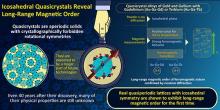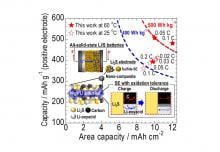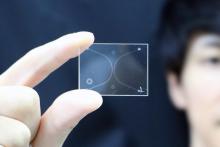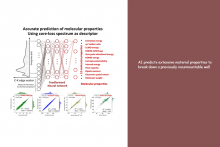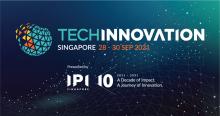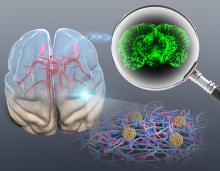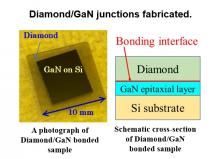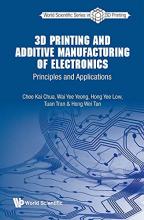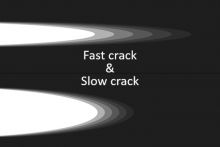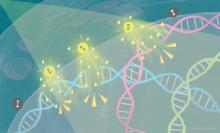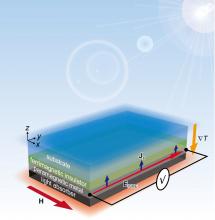Materials
News
22 Nov 2021
Since the discovery of quasicrystals, solids that mimic crystals in their long-range order but lack periodicity, scientists have sought physical properties related to their peculiar structure. Now, an international group of researchers has reported a long-range magnetic order in QCs with icosahedral symmetry that turns ferromagnetism below certain temperatures.
22 Nov 2021
In 2019, a new superconductor was discovered amongst the nickelates (nickel-based oxides), but only now have the underlying physical and chemical similarities with their Periodic-Table twin superconductors, the cuprates, been identified.
16 Nov 2021
Researchers at The University of Tokyo use numerical simulations to model the process called devitrification during which glasses crystallize, which may help improve the long-term stability of glassy materials, like pharmaceuticals and smartphone screens.
04 Nov 2021
A research led by scientists from City University of Hong Kong (CityU) has successfully developed a super-strong, highly ductile and super-light titanium-based alloy using additive manufacturing, commonly known as 3D printing. Their findings open up a new pathway to design alloys with unprecedented structures and properties for various structural applications.
02 Nov 2021
Researchers from The University of Tokyo Institute of Industrial Science use optical microscopy to form a picture of what’s really going on inside surfactant onions
28 Oct 2021
Researchers succeed in developing a lithium sulfide cathode containing a solid electrolyte with high decomposition resistance, enabling the realization of all-solid-state lithium-sulfur batteries that exceed the energy density of lithium-ion batteries
19 Oct 2021
When liquid meets gas, a unique zone forms. Variable by nature, molecules can cross from one state to another, combining in unique ways to either desirable or unwanted ends. From heat escaping a mug of coffee to increasing molecular concentrations in chemical solutions, gas-liquid interfaces are ubiquitous across nature and engineering. But a lack of tools capable of precisely controlling such gas-liquid interfaces limit their applications — until now.
15 Oct 2021
Researchers from The University of Tokyo Institute of Industrial Science use a machine learning approach to successfully predict material properties that have never before been determined
01 Oct 2021
Researchers develop a composite film that can be used in nanogenerators to generate electricity from mechanical motion
29 Sep 2021
A quick, cost-effective approach improves the accuracy with which machine learning models can predict the properties of new materials.
23 Sep 2021
IPI’s flagship technology brokerage event will spotlight the latest global sustainability solutions from 28 to 30 September 2021.
20 Sep 2021
Twisting light that switches direction at room temperature could be the future of quantum information processing.
14 Sep 2021
Researchers at Jilin University, China, reviewed recent progress in the study of Salvinia leaves and their artificial replicas.
14 Sep 2021
When it comes to cancer, clarity is key. The ability to visualize cancerous tumors and metastatic tissue three dimensionally (3D) can help clinicians diagnose the precise type and stage of cancer, while also informing the best treatment methods. To obtain an even clearer tissue for imaging, a research team based in Japan has tested the effectiveness of specialized hydrogels. Acting as a 3D molecular network, these hydrogels can rapidly remove fats from tissues, which are a factor in tissue opacification, without losing their structure. The material is used in several biomedical devices, including contact lenses.
13 Sep 2021
iCeMS scientists and colleagues have designed a molecular code that powers up cancer-fighting immune cells.
09 Sep 2021
Researchers succeed in the direct bonding of diamond and gallium nitride (GaN) at room temperature and demonstrate that the bond can withstand heat treatments of 1,000℃, making it ideal for the high temperature fabrication process of GaN-based devices. GaN-on-diamond semiconductor material will allow for the next generation of high power, high frequency devices.
02 Sep 2021
Written by contributors ranging from world leading experts and researchers from the Singapore University of Technology and Design (SUTD) and Nanyang Technological University (NTU), 3D Printing and Additive Manufacturing of Electronics: Principles and Applications is designed to be a one-stop guide for anyone interested in the 3D printing of electronics.
01 Sep 2021
Scientists from South Korea add foreign atoms to monolayer graphene in a controlled manner to selectively enhance its desirable properties
26 Aug 2021
Prof. Jong-Soo Lee, DGIST, succeeded in developing green-emitting Cd-Free quantum dot synthesis technology with high color reproduction capability
18 Aug 2021
Scientists in Korea make hand-drawn and flexible pressure sensors that can control a phone from underwater.
30 Jul 2021
Researchers from The University of Tokyo Institute of Industrial Science develop an experimentally supported mathematical model that defines the velocity jump mechanism in crack propagation
19 Jul 2021
Researchers from The University of Tokyo Institute of Industrial Science report a machine learning-based model for predicting the bonding properties of materials
18 Jul 2021
Using a CeO2 catalyst, researchers develop an effective catalytic process for the direct synthesis of polycarbonate diols without the need for dehydrating agents. The high yield, high selective process has CO2 blown at atmospheric pressure to evaporate excess water by-product allowing for a catalytic process that can be used with any substrate with a boiling point higher than water.
14 Jul 2021
Researchers have found a way to enhance radiation therapy using novel iodine nanoparticles.
13 Jul 2021
As rechargeable batteries get more powerful, the chance of batteries overheating –thermal runaway - increases. Seeking a way to make batteries safer, researchers have investigated one of thermal runaway’s main triggers: oxygen release.

08 Jul 2021
ARN's July newsletter features research about a promising treatment candidate to reverse dementia, a newly discovered climate pattern, using starch in tiny energy devices, exploring earth Earth ecosystems and the photo of the month.
05 Jul 2021
Osaka Prefecture University develops a method to design and control the path of electron flow in a polycrystalline material. Using epitaxial growth approach, researchers address the electrical conductivity problem of thin film materials by realizing a highly conductive in-plane orientation of a metal-organic framework. Furthermore, they show that it is possible to fabricate oriented thin film patterns by integration with UV lithography technology.
05 Jul 2021
Scientists used digital circuitry to manipulate and store label-free matters in order to study their unique characteristics
30 Jun 2021
Researchers from The University of Tokyo Institute of Industrial Science and Fudan University experimentally interrogate a phenomenon that bridges diverse fields of science and engineering
29 Jun 2021
Magnetic layers interact with sunlight differently, creating a temperature gradient that generates electricity day and night.
Events
Sorry, no events coming up for this topic.
Researchers
Sorry, no researchers coming up for this topic.
- « first
- ‹ previous
- 1
- 2
- 3
Giants in history
Abdus Suttar Khan (c. 1941 – 31 January 2008) was a Bangladeshi engineer who spent a significant part of his career conducting aerospace research with NASA, United Technology and Alstom.
Lin Lanying (7 February 1918 – 4 March 2003) was a Chinese material engineer remembered for her contributions to the field of semiconductor and aerospace materials. Lanying was born into a family who did not believe in educating girls and she was not allowed to go to school.


